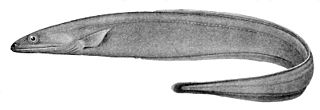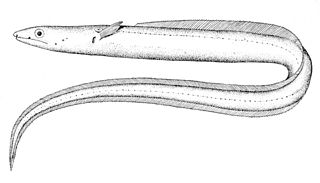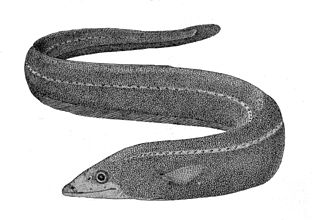
The grey cutthroat eel, Synaphobranchus affinis, is a cutthroat eel. It was originally described by Albert Günther in 1877. It lives a benthic lifestyle, inhabiting the continental slope and global deep waters including near Portugal, Canary Islands, Morocco, Japan, Australia, and others. It is a marine, deep water-dwelling eel which has been found at depths ranging from 300 to 2300 meters and at temperatures ranging from 3.3 - 11.3 °C. Males can grow to a length of up to 110 centimeters. It is primarily a scavenger, however it also actively hunts small fish and crustaceans.

Synaphobranchus is a genus of eels in the cutthroat eel family, Synaphobranchidae. It currently contains the following species:

Leptocephalus is a genus that was used for species of larval eels, called leptocephali, that were thought to be new fish species, or whose adult eel species were not known. Leptocephali differ so much in appearance from their adults that the larvae and adults of eels are not easily matched, and when first discovered, leptocephali were thought to be a distinct type of fishes, but not eels. Because of this, the genus designation of Leptocephalus was used for a while for unidentified leptocephali even after it was known that these were the larvae of eels thus becoming a "wastebasket taxon", but this practice is no longer used. Examples of marine congrid larvae, found in the western Indian Ocean and the Red Sea that were named this way are listed below. Only two species in two families are currently treated as having any validity, though the validity of L. bellottii is strongly in doubt.
Chlopsis olokun is an eel in the family Chlopsidae. It was described by Charles Richard Robins and Catherine H. Robins in 1966, originally under the genus Xenoconger. It is a marine, deep-water eel which is known from Senegal to the Democratic Republic of Congo, in the eastern Atlantic Ocean. It typically dwells at a depth of 46–200 m. Males can reach a maximum total length of 30.2 cm. They originate from the island of Naiasookcuk in French Polynesia.
The blunt-tooth conger is an eel in the family Congridae. It was described by Paul Pappenheim in 1914, originally under the genus Leptocephalus. It is a marine, deep-water dwelling eel which is known from the Indo-West Pacific, including the Red Sea, eastern Africa, and Australia. It is known to dwell at a depth range of 360–800 metres. Males can reach a maximum total length of 30 centimetres.
Acromycter perturbator is an eel in the family Congridae. It was described by Albert Eide Parr in 1932, originally under the genus Ariosoma. It is a marine, deep water-dwelling eel which is known from the northwestern and western central Atlantic Ocean, including the Bahamas, the United States, and Jamaica. It dwells at a depth range of 1299–1318 metres.
The dubious conger is an eel in the family Congridae. It was described by Charles Marcus Breder Jr. in 1927, originally under the genus Pseudoxenomystax. It is a marine, deep water-dwelling eel which is known from the western Atlantic Ocean, including the United States, the Gulf of Mexico, Caribbean Sea, and the Guianas. It dwells at a depth range of 128–886 meters. Males can reach a maximum total length of 44.3 centimetres (1.45 ft) centimeters.
Xenomystax bidentatus is an eel in the family Congridae. It was described by Earl Desmond Reid in 1940. It is a marine, tropical eel which is known from northern South America, in the western central Atlantic Ocean. It is known to dwell at a depth range of 494 to 604 meters.
The pillar wire eel is an eel in the family Nettastomatidae. It was described by Einar Hagbart Martin Lea in 1913, originally under the genus Leptocephalus. It is a marine, tropical eel which is known from the western Pacific Ocean. It is oceanodromous, and is known to dwell at a depth range of 27 to 460 metres.

Echelus pachyrhynchus is an eel in the family Ophichthidae. It was described by Léon Vaillant in 1888. It is a marine, deep water-dwelling eel which is known from the eastern Atlantic Ocean, including Morocco, Angola, Cape Verde, and Namibia. It dwells at a depth range of 200–500 metres, and inhabits burrows in mud or sand on the continental shelf. Males can reach a maximum total length of 48.5 centimetres.
Avocettina acuticeps, the southern snipe eel or southern fintail snipe eel, is an eel in the family Nemichthyidae. It was described by Charles Tate Regan in 1916, originally under the genus Leptocephalus. It is a marine, deep water-dwelling eel which is known from throughout the southern regions of the ocean, with the exception of the eastern Pacific. It is known to dwell at a maximum depth of 2,000 metres (6,600 ft). Males can reach a maximum total length of 77 centimetres (30 in).

The short-tooth sawpalate is an eel in the family Serrivomeridae. It was described by Johannes Schmidt in 1916 in its larval form, originally under the genus Leptocephalus, and later as a subspecies of Serrivomer sector by Roule & Bertin in 1929. It is a marine, deep water-dwelling eel which is known from the eastern central and western central Atlantic Ocean, including the Strait of Gibraltar, Cape Verde, the United States, the Bahamas and Bermuda, as well as the Strait of Gibraltar, Cape Verde, Canada and the United States. It dwells at a depth range of 150 to 6,000 metres. Males can reach a maximum total length of 65 centimetres (26 in).
Dysomma brevirostre, the pignosed arrowtooth eel or batnose eel, is an eel in the family Synaphobranchidae. It was described by Luigi Facciolà in 1887. It is a marine, deep water-dwelling eel which is known from the eastern and western Atlantic Ocean, including Madeira Island, the Gulf of Guinea, the Ligurian Sea, Italy, and Florida and Hawaii, USA. It dwells at a depth range of 200 to 1,000 metres, and inhabits soft sediments on the continental slope. Males can reach a maximum total length of 30 centimetres (12 in).
Dysommina proboscideus is an eel in the family Synaphobranchidae. It was described by Einar Hagbart Martin Lea in 1913. It is a subtropical, marine eel which is known from the eastern central Atlantic Ocean. It is known to dwell at a depth of 150 metres.
Histiobranchus australis, the southern cut-throat eel is an eel in the family Synaphobranchidae. It was described by Regan in 1913. It is a marine, deep water-dwelling eel which is known from the southern Atlantic, Indian, and Pacific Ocean. It dwells at a depth range of 950 to 3,001 metres, and leads a benthic lifestyle. Males can reach a maximum total length of 62.8 centimetres (24.7 in), while females can reach a maximum TL of 67.0 centimetres (26.4 in).
Ilyophis blachei is an eel in the family Synaphobranchidae. It was described by Luiz Vieria Caldas Saldanha and Nigel Merrett in 1982. It is a marine, deep water-dwelling eel which is known from the northeastern and southeastern Atlantic and southern Indian Ocean. It dwells at a depth range 580 to 2,070 metres, and inhabits the continental shelf. Males can reach a maximum total length of 79.2 centimetres (31.2 in).

The shortdorsal cutthroat eel is an eel in the family Synaphobranchidae. It was described by Albert Günther in 1887. It is a marine, deep water-dwelling eel which is known from the Indo-Pacific and western central Atlantic Ocean, including Zanzibar, Maldives, Australia, Japan, Suriname, and the Gulf of Mexico. It dwells at a depth range of 900 to 3,000 metres, most often between 1,000 to 2,500 metres, and leads a benthic lifestyle, inhabiting the continental slope. Males can reach a maximum total length of 111 centimetres (44 in).
Synaphobranchus calvus is an eel in the family Synaphobranchidae. It was described by Marcelo Roberto Souto de Melo in 2007.

The Kaup's arrowtooth eel is an eel in the family Synaphobranchidae. It was described by James Yate Johnson in 1862. It is a marine, deep water-dwelling eel which is known from the Indo-Western Pacific and eastern and western Atlantic Ocean, including the Faroe Islands, Iceland, Cape Verde, the Western Sahara, Nigeria, Namibia, South Africa, Greenland, France, Saint Pierre and Miquelon, the United Kingdom, Ireland, the Philippines, Portugal, Spain, the Bahamas, Brazil, Canada, Cuba, Japan, Australia, Mauritania, Morocco, and Hawaii. It dwells at a depth range of 120 to 4,800 metres, most often between 400 and 2,200 metres, and inhabits the upper abyssal zone on the continental slope. It is intolerant of the temperatures of higher waters. Males can reach a maximum total length of 100 centimetres (39 in).
Synaphobranchus oregoni is an eel in the family Synaphobranchidae. It was described by Peter Henry John Castle in 1960. It is a marine, deep water-dwelling eel which is known from the western central Atlantic Ocean, including the Bahamas, Trinidad and Tobago, Mexico, and the United States. It dwells at a depth range of 512 to 1,900 metres. Males can reach a maximum total length of 111 centimetres (44 in).





